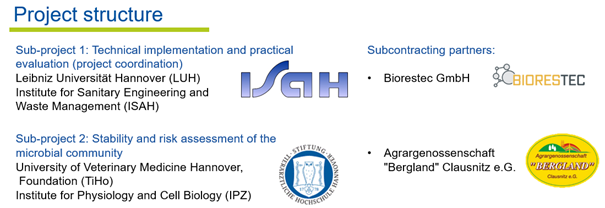Daumen 3.0 - Practical implementation of the DAUMEN process for the use of raw fibre-rich substrates in biogas plants; sub-project 1: Process engineering implementation and practical evaluation

| Led by: | PD Dr.-Ing. habil. Dirk Weichgrebe |
| E-Mail: | weichgrebe@isah.uni-hannover.de |
| Team: | Lukas Illi, M.Sc. |
| Year: | 2023 |
| Funding: | Bundesministerium für Ernährung und Landwirtschaft (BMEL), Projektträger: FNR (Fachagentur für Nachwachsende Rohstoffe) |
| Duration: | 10/2020 - 09/2023 |
Worldwide, agricultural residues with a high crude fibre content are produced in large quantities. A large part of the residues - especially in emerging countries - are burnt directly on the field and causes considerable air pollution. Such biomass potential is also available in Europe, from which biogas could be produced as regenerative energy through suitable technical solutions. The innovative "DAUMEN" (Design for Separation and Augmented Methanisation) process offers such an effective and economical technical solution through the bionic implementation of the pre-gastric system of ruminants and the use of the efficient rumen biocenosis. With the joint project DAUMEN 3.0, Institute for Sanitary Engineering and Waste Management (ISAH, project coordination) of the Leibniz Universität Hannover and the Institute for Physiology and Cell Biology (IPZ) of the University of Veterinary Medicine Hannover, Foundation, are implementing the process in practice and integrating it into the biogas plant (BGA) of Agrar-G. "Bergland" in Clausnitz. The high-load reactor for hydrolysis and acidification (HRHV) simulates the high space-time yield of the rumen. Due to an established rumen flora, the reactor is suitable for efficiently digesting residues that are difficult to degrade and for producing short-chain fatty acids. These are fed to the BGA as a productive substrate.
In sub-project 1, the separation stage for decoupling the retention of solids and liquid phase - corresponding to the reticulum in ruminants - is first optimised in the pilot plant. The HRHV and the separation stage will be used in practical tests with separated digestate, flax straw and solid manure, among others. Substrate-specific operating parameters and process variables are recorded and evaluated. The overall system consisting of HRHV and biogas plant is evaluated. The overall system of HRHV and biogas plant is represented by a mathematical model based on ADM1xp_HRHV in order to calculate both the repowering of existing plants and the performance of new plants and to enable transferability to other substrates. A balance of material and energy flows as well as a profitability analysis to determine the investment and operating costs for market implementation complete the project. The participation of the agricultural cooperative "Bergland" Clausnitz e.G., Clausnitz, and the KMU BIORESTEC GmbH, Laatzen, ensures a rapid implementation of the research results in practice.
In sub-project 2, the IPZ will monitor the trials from a molecular biological and epidemiological point of view in order to evaluate the performance of the rumen flora and to document its safety in terms of epidemiological hygiene.
Further information on the project can be found under the following link:















